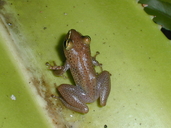|
Guibemantis annulatus Lehtinen, Glaw & Vences, 2011
Ring-wearing Tree Frog Subgenus: Pandanusicola | family: Mantellidae subfamily: Mantellinae genus: Guibemantis |
| Species Description: Lehtinen RM, Glaw F, Vences M. 2011. Two new plant-breeding frog species (Anura: Mantellidae, Guibemantis) from southeastern Madagascar. Herpetological Journal 21: 95–112. | |
 © 2011 Richard Lehtinen (1 of 4) |
|
|
|
Description G. annulatus can be distinguished from G. punctatus by having a lighter dorsal ground color, rounded dorsal spots that are smaller and more regular, digits with conspicuous light “rings” just proximal to each toe or finger disc, the presence of an unbroken gold (in life) rostral stripe medial to a black rostral stripe, small dark spots on the dorsal surfaces of limbs (vs thick bars in G. punctatus), a relatively longer femur, tibia and foot, a wider head, a wider internarial distance, males with larger femoral glands, and DNA sequence differences. Distribution and Habitat Country distribution from AmphibiaWeb's database: Madagascar
Life History, Abundance, Activity, and Special Behaviors Trends and Threats Relation to Humans Comments Species authority: Lehtinen et al. (2011). Etymology: The specific epithet annulatus refers to the white “rings” found below each finger or toe disc.
References
Lehtinen, R. M. (2002). ''The use of screw pines (Pandanus spp.) by amphibians and reptiles in Madagascar. .'' The Herpetological Bulletin, 82, 20-25. Lehtinen, R. M. (2003). ''Parental care and reproduction in two species of Mantidactylus (Anura: Mantellidae).'' Journal of Herpetology, 37, 766-768. Lehtinen, R. M. (2004). ''Tests for competition, cannibalism and priority effects in two phytotelm-dwelling tadpoles from Madagascar.'' Herpetologica, 60, 1-13. Lehtinen, R. M. (2005). ''Competitive interactions and distributional dynamics in two Malagasy frogs.'' Journal of Tropical Ecology, 21, 569-576. Lehtinen, R. M. (2009). ''The natural history of two plant-breeding frogs from Madagascar, Guibemantis bicalcaratus and G. punctatus (Anura: Mantellidae).'' Salamandra, 45, 39-49. Lehtinen, R. M., Glaw, F., and Vences, M. (2011). ''Two new plant-breeding frog species (Anura: Mantellidae, Guibemantis) from southeastern Madagascar.'' The Herpetological Journal, 21, 95-112. Lehtinen, R. M., and Carfagno, G. L. F. (2011). ''Habitat selection, the included niche and coexistence in plant-specialist frogs from Madagascar.'' Biotropica, 43, 58-67. Originally submitted by: Richard M. Lehtinen (first posted 2012-02-07) Edited by: Kellie Whittaker (2012-03-13) Species Account Citation: AmphibiaWeb 2012 Guibemantis annulatus: Ring-wearing Tree Frog <https://amphibiaweb.org/species/7653> University of California, Berkeley, CA, USA. Accessed Nov 21, 2024.
Feedback or comments about this page.
Citation: AmphibiaWeb. 2024. <https://amphibiaweb.org> University of California, Berkeley, CA, USA. Accessed 21 Nov 2024. AmphibiaWeb's policy on data use. |



 Map of Life
Map of Life